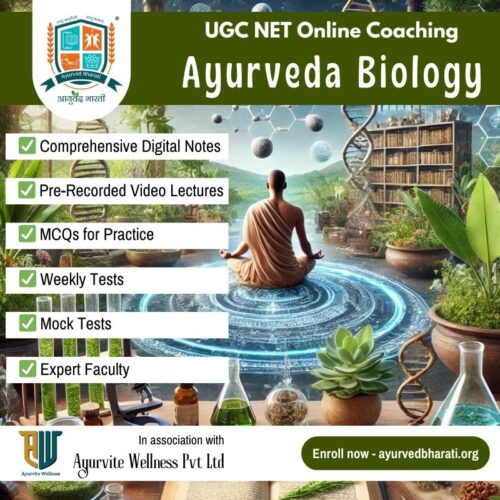UGC NET Ayurveda Biology coaching
- Course Validity: 12 months
- Resources: LMS and Digital Library Access – Pre-recorded video lectures in Hindi, Downloadable Digital Notes in English, MCQs & Mock Tests
- Content: Covers entire UGC NET Ayurveda Biology syllabus
- Language: Lectures – majorly in Hindi, Reading materials & test series in English
UGC NET Ayurveda Biology Coaching – Key Highlights
- Mode: 100% Online
- Study Materials: Comprehensive downloadable digital notes, pre-recorded videos, MCQs for practice, mock tests, printed book set of 3 books (can be purchased, not included in this course fee).
- Syllabus: Covers all 10 units recommended by UGC NET
- Expert Faculty: Experienced professionals specializing in Ayurveda and biology.
- Flexible Learning: Self-paced study with recorded lectures and accessible resources.
- Designed for Beginners & Experts: Tailored content for all levels of aspirants.
Click here for demo lessons/ videos
Limited Seats, have you booked your’s?
Q71. Which of the following is TRUE for nucleosome core?
Option A. Consist of H1 histone protein
Option B. Consist of one unit each of H2A, H2B, H3, and H4
Option C. Consist of two units each of H2A, H2B, H3, and H4
Option D. Consist of two units of H1 protein
Correct Ans – Option C (Two units each of H2A, H2B, H3, and H4)
Explanation –
The nucleosome core particle has an octamer of histones: 2 of each H2A, H2B, H3, and H4. H1 is the linker histone.
Q72. Which technique is used for identifying bacteria at molecular level?
Option A. 18s rRNA sequencing
Option B. 16s rRNA sequencing
Option C. 32s rRNA sequencing
Option D. 24s rRNA sequencing
Correct Ans – Option B (16s rRNA sequencing)
Explanation –
16s ribosomal RNA sequencing is a widely used molecular technique to identify bacteria, as it contains both conserved and variable regions.
Q73. Match the List-I with List-II (Physiology vs Hormone):
| Physiology Function | Hormone |
| A. Regulation of metabolic rate | III. Thyroxine |
| B. Regulation of Blood Pressure | IV. Vasopressin |
| C. RBC synthesis | I. Erythropoietin |
| D. Stress Response | II. Epinephrine |
Correct Ans – Option 3 (A-III, B-IV, C-I, D-II)
Explanation –
- Thyroxine → metabolic rate
- Vasopressin → blood pressure
- Erythropoietin → RBC production
- Epinephrine → stress response
Q74. Which among the following is a commentator of Charak Samhita?
Option A. Chakrapani Dutta
Option B. Hemadri
Option C. Jejjat
Option D. Vachaspati
Correct Ans – Option A (Chakrapani Dutta and B Only)
Explanation –
Chakrapani Dutta is the most recognized commentator on Charaka Samhita. Jejjat and others are associated with different contexts or texts.
Q75. Match List-I (Term) with List-II (Origin / Karma):
| Term | Origin/Karma |
| A. Man | IV. Chintya |
| B. Purusha | II. Bhautik |
| C. Indriya | III. Shaddhatuj |
| D. Mahabhuta | I. Vayu |
Correct Ans – Option 2 (A-IV, B-III, C-II, D-I)
Explanation –
- Manas → Chintya (mind-perceivable)
- Purusha → Shaddhatuj (combination of 6 elements)
- Indriya → Bhautik (material origin)
- Mahabhuta → Vayu as a component
Q76. What is the Prakriti of the person?
(A tall, lean man with premature greying, skin issues, sweating, irritability, and stomatitis episodes.)
Correct Ans – Option 2 (Pitta Dominant)
Explanation –
Symptoms like premature greying, skin rashes, irritability, body odor, and sweating align with Pitta dominance.
Q77. What is the dietary advice he would be prescribed?
Option A. Tikta Rasa, Cool, Heavy diet
Option B. Katu Rasa, Fermented items
Option C. Fasting, Spicy, light diet
Option D. Sour, oily, unripe fruits
Correct Ans – Option A (Tikta Rasa, Cool, Heavy diet)
Explanation –
To balance aggravated Pitta, cooling, bitter (Tikta), and nourishing (heavy) foods are recommended in Ayurveda.
Q78. Which of the following physical activities is he generally advised NOT to do?
Option A. Jogging
Option B. Cycling
Option C. Heavy weight lifting
Option D. Swimming
Correct Ans – Option D (Swimming)
Explanation –
Swimming can aggravate cold-related imbalances, especially for someone with weakened immunity or aggravated Pitta, depending on context and season.
Q79. What disease/disorders would this person be more prone to?
Option A. Obesity
Option B. Bleeding disorder
Option C. Osteoarthritic disorder
Option D. Indigestion
Correct Ans – Option D (Indigestion)
Explanation –
Pitta individuals are prone to digestive disorders, hyperacidity, and inflammatory conditions rather than obesity or arthritis.
Q80. What could be the possible infection the person may be suffering from?
(Symptoms: repeated opportunistic infections, T-cell fall, Kaposi’s sarcoma, blood transfusion history.)
Correct Ans – Option 3 (Human Immunodeficiency Virus)
Explanation –
This describes AIDS, caused by HIV, characterized by T-cell depletion and opportunistic infections like Kaposi’s Sarcoma.

